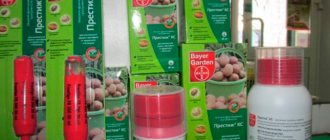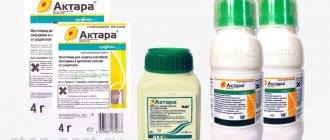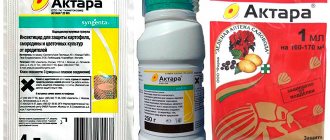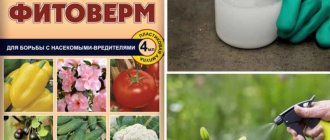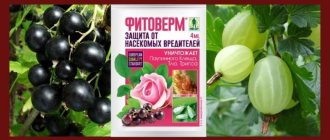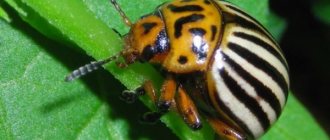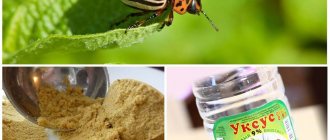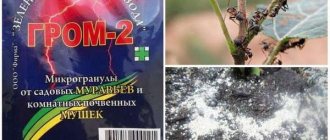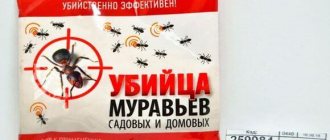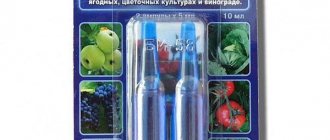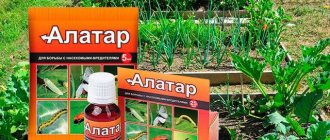Home / Preparations and fertilizers
Back
Published: 06/22/2019
3
Rate this post
Insect pests are capable of destroying a future harvest in a short period of time. It is difficult to fight them, since beetles and caterpillars become addicted to many products. One of the effective insecticides is Calypso, which is part of the group of drugs based on neonicotinoids. It has proven itself well on various crops in exterminating dangerous insects, and the instructions for use are simple and understandable.
- 1 Description and mechanism of action 1.1 Advantages and disadvantages
- 2.1 Precautions for processing
For what pests is it used?
The insecticide is used to destroy Coleoptera, Homoptera, and Lepidoptera harmful insects.
Insecticide "Calypso" is low-toxic for people and animals
Effective against almost all parasites, including:
- apple blossom beetle;
- leaf rollers;
- scale insects;
- rapeseed flower beetle;
- cluster budworm;
- Colorado potato beetle;
- May beetle larvae;
- thrips;
- scoop;
- aphids;
- cherry fly.
Cases of parasite resistance to treatment are rare, but it is more effective to alternate different types of products during application.
Analogues of the product, compatibility
Calypso insecticide is compatible with various compounds (fungicides, growth stimulants), excluding copper-containing and alkaline solutions. But experts recommend using it as a separate poison, alternating with other drugs.
Pest exterminators with similar effects:
- Opercot is an insecticidal preparation of the pyrethroid group, used to combat harmful insects and for disinfestation;
- Enzhio is an intestinal-systemic remedy, effective against larvae and adults. Produced by Syngenta;
- KS-Pondus - produced by Keminova LLC (Denmark), has a high economic return, is effective for processing apple orchards;
- Diazine Euro is a drug from the group of organophosphorus compounds, containing the poison diazinon. Gives good results in exterminating moths, white beetles, weevils, and ground beetles.
Advantages and disadvantages
The agrochemical is not phytotoxic and poses virtually no danger to animals or beneficial insects.
Advantages of the Calypso insecticide:
- long validity period (up to a month);
- Can be used in open ground and greenhouses, for indoor plants;
- You can process vegetable and industrial crops, fruit trees, and berry fields.
Disadvantages include:
- inability to use near water bodies and fishing grounds;
- Treatment should not be carried out in the heat, 2 hours before and after rain.
The disadvantages include the high cost, which is offset by the rapid action of the product.
Advantages of Calypso
- Helps increase the yield of fruit and berry plants;
- Reliably protects crops from pests for a month;
- It is especially effective against flower beetles and leaf rollers;
- Has a rapid insecticidal effect (pests die within 3 hours from the moment of treatment);
- Does not cause stress to the treated plants, is not phytotoxic, provided that application standards are observed;
- Can be used without restrictions;
- If the instructions are followed, it does not pose a danger to beneficial entomofauna (the border-flight zone should not be less than 2 km, the summer limit is 1.5 days);
- Can also be used for indoor plants;
- It can be combined with other preparations for tank mixtures, with the exception of those containing copper or those with an alkaline reaction, but you should still first carry out a test for the compatibility of the components;
- Can be used both on small garden plots and on large agricultural lands.
Consumption rate of insecticide "Calypso"
For different crops you will need:
| Plant type | Dosage |
| Potatoes, tomatoes | 1 ml of suspension per 5 liters of water per 1 hundred square meters |
| Apple tree | 2 ml of suspension per 10 liters of water |
| Grape | 2 ml of suspension per 10 liters of water per 1 hundred square meters |
| Strawberries, garden strawberries | 2 ml of suspension per 10 liters of water |
| Cabbage | 2 ml of suspension per 10 liters of water |
Selectivity does not limit the use of an insecticide.
The insecticide "Calypso" can be used to treat vegetable and industrial crops
Composition and principle of action
Calypso is a chemical that can be used to control insects and fungal diseases. This drug instantly destroys vegetable pests (potato beetles, May beetle larvae), protects tomatoes and potatoes from late blight, and is also used as a growth stimulator.
The active ingredient of the drug is thiacloprid. This ingredient helps destroy pests of vegetable and garden crops. Thiacloprid acts on the central nervous system of insects (blocks the transmission of nerve impulses). The active substance leads to paralysis, convulsions and death of pests. This is an enteral and contact insecticide that destroys sucking and biting pests.
The effect is noticeable within 60-180 minutes after spraying. The period of protective action is 2-4 weeks (depending on weather conditions). The product destroys insects by direct contact with them, as well as by eating poisonous parts of plants. The active ingredient of the insecticide is able to penetrate the tissues of vegetable plants.
"Calypso" is in liquid form (suspension concentrate). It is packaged in ampoules (2 ml) or plastic bottles (1 l). Before use, the drug should be diluted with water. One hectare requires 0.5 liters of Calypso. This insecticide was developed by Bayer in Germany.
Instructions for use of the drug
"Calypso" is a contact insecticide. The instructions for use compiled by the manufacturer assume its use throughout the growing season.
To properly prepare a solution for spraying, you must:
- Mix the suspension with 100 ml of water. Dilute the prepared concentrate in 10 liters of water.
- For spraying, only a solution prepared within 12 hours is used.
Treatment can be carried out from spring to autumn.
What does it help with?
Calypso is a systemic intestinal insecticide that controls sucking and biting pests of homoptera, lepidoptera and coleoptera: thrips, moths, psyllids, flies, fawns, white moths, cutworms, weevils, Colorado potato beetles, flower beetles, sawflies, bronze beetles, various aphids and codling moths. In addition, the drug protects nightshade plants from late blight.
The use of Calypso is allowed on such crops as:
- apple;
- gooseberry;
- beet;
- pears;
- tomatoes;
- cabbage;
- potato;
- garlic;
- cherries;
- Rowan;
- hawthorn;
- quince;
- grape;
- pepper;
- bird cherry;
- peach;
- onion;
- plums;
- currant;
- strawberry.
Precautionary rules
The agrochemical is low-toxic, but safety precautions must be strictly observed. To protect yourself, you will need:
- protective suit;
- latex gloves;
- respirator;
- protective glasses.
After the treatment process, it is recommended to take off your work clothes, take a shower, and wash your hands and face with soap. Spraying is stopped 2-3 weeks before harvest.
A protective suit and rubber gloves will be required to protect yourself.
Toxicity
Calypso is a toxic substance of hazard class 2. The drug is dangerous for aquatic organisms: do not use the drug near fishing grounds or water sources. It is also unacceptable for the drug to enter animal feed, therefore it is prohibited to graze livestock in areas freshly treated with Calypso.
If the dosage is strictly observed, Calypso is completely safe for plants and humans.
First aid for poisoning
"Calypso" is an insecticide for killing insects. It is recommended to use the drug strictly as prescribed by a doctor. It is prohibited to swallow the insecticide or inject it into animals and birds. If the drug enters the human body, drink several glasses of water with baking soda, induce vomiting and take activated charcoal tablets. If an animal is poisoned, take immediate action. We recommend that you drink plenty of drinks and take a few activated charcoal tablets.
Phytotoxicity
At registered doses it is not phytotoxic to cultivated plants.
Combination with other drugs, analogues
In agricultural settings, farmers often mix Tabu with other pest control products because they do not want to doubt the result. This drug interacts well with pesticides such as:
- “Vitaros” – stimulates the growth of vegetables, destroys pests;
- “Bunker” – used against infectious soil diseases;
- "Vial Trust" is a domestically produced disinfectant and pesticide.
Instead of con, you can use their analogues:
- “Tuber Shield” – provides protection against harmful insects and infections;
- “Commander” - used to combat not only the Colorado potato beetle, but also aphids and psyllids;
- “Provotox” is available in granules and is effective for six to seven weeks.
Before the appearance on the market of the drug “Taboo” for wireworms and the Colorado potato beetle, gardeners considered “Prestige” to be the most popular remedy. Both are considered worthy products in their category, but if you compare the two disinfectants, you will notice some differences. If you are wondering what to buy, “Prestige” or “Taboo” for Colorado beetles, keep in mind that the second remedy lasts longer and costs less. But at the same time, “Prestige” stimulates the growth of potatoes and is a fungicide, that is, it fights fungal diseases.
Price
| 1 bottle | 1 liter bottle | 11,450 rubles per liter | 11,450 rubles per bottle |
| 12 pieces per pack | 12 bottles per 1 liter | 11030 rubles per liter | 132,360 rubles for 12 bottles of 1 liter |
Also available in 2 ml capsules, 10 ml bottles and 1 liter containers. The price of Calypso also depends on the volume of the drug. The minimum dosage costs between 30-40 rubles. Pesticide against the Colorado potato beetle can be purchased in specialized stores or ordered online.
Pros and cons of the drug
The main advantages of the Kallipso insecticide include:
- the product protects plants for a long period;
- the drug does not have a toxic effect on cultivated plants;
- does not cause addiction to insects;
- if all rules and dosages of the product are followed when diluting, then the product does not have a toxic effect on bees and inhabitants of water bodies;
- The insecticide has a quick effect on pests.
After spraying, the treated plants do not experience stress, and their development is not delayed.
The product also improves the quality of fruits, and the amount of carrion in fruit trees is reduced. The negative qualities of Calypso include:
- The cost of the drug is quite high, but it is compensated by the high effectiveness of the drug;
- Treatments of cultivated plants are carried out strictly according to the scheme and taking into account weather conditions, since in the heat or during rains the effectiveness of the product decreases.
First aid
The recommendations below are intended only for providing FIRST aid, after which you should immediately consult a doctor and follow his instructions! DO NOT SELF-medicate!
- When the first signs of poisoning appear - nausea, vomiting, general weakness, headache, dizziness - the victim should be removed from the area of effect of the drug and his clothes changed.
- If the insecticide gets on your skin, remove it with a cloth or cotton wool and rinse the area under running water.
- If the drug gets into your eyes, rinse them under running water, trying to keep them open.
- After getting the working solution inside, take 4-5 tablets of activated carbon with several glasses of water, and try to induce vomiting. If the victim is unconscious, vomiting should not be induced.
- After providing first aid, you should consult a doctor.
Security measures
The drug "Calypso" belongs to class 2. It is toxic to humans. It is prohibited to store it near medicines and food products. If the product enters the digestive tract, symptoms of severe intoxication may appear.
The product is considered relatively safe for bees and birds. But it is toxic to waterfowl. It is necessary to ensure that the insecticide does not get into water bodies. Also, it should not get into livestock feed; grazing of animals in newly treated areas is prohibited.
Important! It is necessary to treat plants with Calypso in the morning or evening hours in calm weather.
Calypso remedy for the Colorado potato beetle
The threat of infection of vegetable crops by harmful insects remains relevant from year to year. And so that green spaces do not get sick and produce a full harvest, gardening enthusiasts use various pesticides. Such products come in the form of powders and tablets, concentrated emulsions and granules. Referring to reviews of Calypso for the Colorado potato beetle, many gardeners include this drug in the list of well-proven remedies. The features of the composition of this drug, as well as the rules for its use, will be discussed in this article.
Related article: Cardinal preparation for potatoes: instructions and dosage
Reviews
Galina, 46 years old, Volgograd region
I regularly use Calypso to control pests in my garden beds. The drug is very effective and quickly acts on pests. At the same time, the insecticide does not have an unpleasant “smell”, which does not accumulate in plants. However, I still recommend doing the final application about 25-30 days before harvest.
Michal, 50 years old, Samara region
In our garden, a large area is dedicated to potatoes, which we grow for sale. Therefore, it is very important for us to effectively combat the potato beetle, which can destroy the entire potato crop. For these purposes we use Calypso. After treatment with this drug, many dead beetles, as well as their larvae, remained on the ground. And even after several weeks there were no beetles visible on the tops of the potatoes. I can note that, for example, “Beetle Eater” did not cause such an effect in our country.
Svetlana, 55, Krasnodar region
My husband and I have a fairly large plot of land where we grow various varieties of grapes for sale. To prevent the grape clusters from being damaged by the grape grasshopper, we use the Calypso insecticide: we dilute it according to the instructions and spray the vines. We also carry out preventive treatments with this drug. As a result, this pest has not appeared on our grape plantation for several years.
Calypso insecticide has a fairly wide spectrum of action against most pests. The treatment can be carried out not only on garden crops, but also on vegetables. Calypso suspension is quite economical, it can be stored for up to 2 years, and pests begin to die within a few hours after treatment. Therefore, this insecticide is indispensable for home and garden owners.
What is an insecticide?
Products created specifically for the extermination of harmful insects, their larvae and eggs are called “insecticides”. There are several groups that affect insects in their own way:
- contact: drugs in this group fight directly against the parasites themselves;
- systemic: the active substance is absorbed into the plant tissue. Pests die after contact with treated crops;
- intestinal: active components penetrate the digestive tract of insects;
- respiratory: the drug destroys the function of the respiratory system of parasites.
The degree of effectiveness of an insecticide is determined by its chemical composition. Knowing what components the drug consists of, we can draw a conclusion about the toxicity of the product and its danger to the environment and humans.
Summer residents and gardeners use insecticides most often to treat vegetables, fruits and grain crops. Today, manufacturers produce almost safe drugs, the actions of which are aimed exclusively at pests. The drug Calypso is one of these drugs.
Effect of the drug, scope of use
3 hours after treatment with Calypso, the pests die.
One of the components of the product is thiacloprid. This substance, when ingested by an insect, disrupts the transmission of nerve impulses. The nervous system is paralyzed due to binding to nicotine acetylcholine receptors. After a single treatment, the insects die. Death occurs within 3 hours.
“Calypso” is used to treat fruit trees and shrubs:
Vegetable crops are also treated with Calypso:
Important! When using the drug "Calypso" several times in a row, resistance may develop. This can be avoided by alternating insecticides.
The product allows you to get rid of the Colorado potato beetle and its larvae, hairy deer. It also protects potato and tomato crops from the development of late blight.
Calypso, KS - systemic insecticide against garden and vegetable pests
Calypso is a systemic insecticide of contact and intestinal action, which allows you to control a wide range of garden pests.
| Active substance: | |
| Thiacloprid | 480 g/l |
| Preparative form | Suspension concentrate |
| Chemical class | Neonicotinoids |
| Penetration method | Enteric pesticide, contact pesticide, systemic pesticide |
| Effect on organisms | Insecticide, pesticide |
| Hazard class for humans | 2 |
| Hazard class for bees | 3 |
| Prohibited for use in the water protection zone of reservoirs | |
| Air handling: | Allowed |
| Production | Imported |
| Package | 1 l. |
| Shelf life | 2 years |
| Registrant | Bayer Crop Science AG |
| Manufacturer | Bayer |
| State registration number | 019-01-1683-1 |
| Registration expiration date | 15.01.2028 |
Note: the Certificate of Registration prohibits the use of water bodies on private farms, by aviation, or in the water protection zone.
Calypso is a systemic insecticide of contact-intestinal action of the chloronicotinyl class against sucking and gnawing pests on apple trees.
Instructions for use of thiacloprid
According to common practice, instructions for the use of a particular substance are developed in relation to preparations containing this substance
Thiacloprid, like other neonicotinoids, binds to the postsynaptic nicotinic acetylcholine receptors of the central nervous system of insects, as a result of which they develop paralysis and convulsions, leading to their death.
It moves weakly along the soil profile and is quickly destroyed in the soil under aerobic conditions.
The compound is metabolized at a very low rate in plants.
Hazard classes. Preparations based on thiacloprid are classified as hazard class 2 for humans and hazard class 3 for bees.
Below is data from the official website of the Bayer JSC campaign.
The action of thiacloprid is based on a disruption in the transmission of nerve impulses, resulting from binding to the nicotinic acetylcholine receptor of the psotsynaptic membrane, which leads to the death of pests.
Purpose
Contact-intestinal insecticide of systemic action of the chloronicotinyl class against sucking and gnawing pests of apple, grape and rapeseed.
Advantage
- An ideal protection tool against flower beetle, leaf roller and other most dangerous pests.
- Long guaranteed period of protective action (up to 30 days).
- Does not create stress for the treated plants.
- Practically not dangerous for beneficial entomofauna, including pollinators.
- Complies with the requirements of anti-resistance policy.
- Reduces the amount of carrion and increases the grade.
- Advantages: • Highly effective tool for controlling bunch and other types of leaf rollers, codling moth, thrips, leafhoppers, aphids and other types of pests
- • The effect is observed within the first hours after treatment
- • Has low toxicity to predatory mites and beneficial entomofauna, including pollinators •
Preparative form
Suspension concentrate containing 480 g/l thiacloprid.
Mechanism of action
The action of thiacloprid is based on disruption of nerve impulse transmission resulting from binding to the nicotine acetylcholine receptor, which leads to the death of pests.
Activity spectrum
A broad-spectrum insecticide, active against Coleoptera (Coleoptera), Lepidoptera (Lepidoptera), Homoptera and other pests.
Period of protective action
From 15 to 30 days, depending on the type of pest and weather conditions.
Impact speed
The effect is observed within the first hours after treatment.
Phytotoxicity
Not phytotoxic to crops at registered application rates.
Selectivity (selectivity)
The drug can be used without restrictions.
Calypso® has a very gentle effect on bees and parasitic entomophagous riders without causing their death and has low toxicity for predatory mites
Compatibility
Compatible with most fungicides and insecticides. However, in each specific case it is necessary to first check for compatibility.
On the site from another document: Selectivity: low risk for bees.
Period of protective action: 15-30 days. Miscibility: Mixes well with many pesticides
Mode of application
| Culture | Harmful object | Consumption rate, l/ha | Mode of application | Waiting period, (number of treatments) Waiting period (number of treatments) | |
| Apple tree | Apple flower beetle | 0,18–0,3 | Spraying during the period of bud release. Working fluid consumption is 600–1000 l/ha. | 7 (1) ;30 (1) | |
| Codling moth, leaf rollers, scale insects | 0,3–0,45 | Spraying during the growing season. Working fluid consumption is 1000–1500 l/ha. | 7 (2) ;30(2) | ||
| Rape | Rapeseed flower beetle | 0,1–0,15 | Spraying during the growing season. Working fluid consumption 200–400 l/ha | 36 (2) | |
| Grape | Bunch leaf roller | 0,2–0,3 | Spraying during the growing season. Working fluid consumption 800–1200 l/ha | 40 (2) |
Despite the lack of permission for use on private farms, the drug is actively sold in bulk by private sellers and on a number of forums in joint purchases. Below is information about the drug from the website of one of the sellers. (3)
Preparative form: Suspension concentrate containing 480 g/l thiacloprid. Spraying of potatoes and vegetable crops is carried out during the growing season, when the first signs of pest damage appear. A single treatment is sufficient to kill many pests. Apple trees are sprayed in the pink bud phase before the flowering phase. Subject to the recommended application rates, the product is safe for bees, allowing spraying also during flowering. The period from the last treatment to harvest: potatoes - 20 days, apple trees - 30 days.
Potatoes, tomatoes - Corolad beetle, aphids, thrips, cutworms 1 ml per 5 liters of water per 1 sq.m. Apple tree - Apple flower beetle, weevils, apple moth, apple sawfly, bypassing moths, hairy deer 2 ml per 10 liters of water per 1 sq.m. Grapes - Gronov's leaf roller 2 ml per 10 liters of water per 1 sq.m. Strawberries - Gray root weevil 2 ml per 10 liters of water per 1 sq.m. Peach - Oriental codling moth, peach aphid 2 ml per 10 liters of water per Sugar beets - Buryak flea beetles, aphids 1- 2 ml per 5 liters of water per 1 sq.m. Onion, garlic - Onion fly, leaf flies, onion thrips, Onion moth 1-2 ml per 5 liters of water per 1 sq.m. Cabbage Scoops, moths, white flies, flea beetles, aphids 1-2 ml per 5 sq.m. l of water per 1 hectare
Spectrum of activity: Broad-spectrum insecticide, active against Coleoptera (Coleoptera), Lepidoptera (Lepidoptera), Homoptera (Homoptera) and other pests. Period of protective action: From 15 to 30 days, depending on the type of pest and weather conditions. Speed of impact: The effect is observed within the first hours after treatment. Phytotoxicity: Not phytotoxic to crops at registered application rates. Selectivity: The drug can be used without restrictions. Possibility of resistance: No cases of resistance have been observed. However, to prevent the emergence of resistance, the drug should be alternated with insecticides from different chemical groups. Compatibility: Calypso does not mix with other drugs, only with adhesives (Liposam)
Consumption rate: 2 ml per 3-4 liters of water
According to another source (4), there are recommendations below for the use of the drug Calypso. Apparently, the authors used and refer to the instructions for the drug in small packaging, which is approved for sale outside the Russian Federation.
The key component thiacloprid destroys the chain of transmission of nerve impulses from the receptors of the following insects: Colorado potato beetles; common and peach aphids; common and onion moths; scoop; weevils; apple flower beetles, sawflies; codling moth and oriental codling moth; hairy alenka; cluster budworm; cherry and onion flies; psyllids; onion thrips; whites.
"Calypso" is used in different concentrations with the calculation of spraying garden plants and garden crops on 1 hectare of land. For processing potatoes and tomatoes - 1 ml of product / 5 liters of water per 100 sq. m. To protect apple trees, peach trees, cherries, cherries, grapes, strawberries, increase the dose by 2 times. To treat pests that have invaded planted onions, garlic, and cabbage, you need to dilute 1-2 ml of the substance from the bottle in 5 liters of water.
To care for indoor flowers, use a solution preparation ratio of 0.5 ml of concentrate per liter of clean water. A long period of action was noted in comparison with other compositions of substances of similar purpose.
Researchers and practicing gardeners have not reported cases of resistance. But to prevent the occurrence of a “conflict,” you should alternate “Calypso” with a pest control product of a different chemical base. During one cycle of plant treatment, the prepared liquid solution is not mixed with other drugs for spraying against pests.
The period between the last spraying of Calypso and harvest should be at least 3-4 weeks. The product does not exhibit phytotoxicity if the drug consumption rates specified in the instructions for use are strictly observed. At the same time, it has a class II toxic threat due to the danger to organisms living in the aquatic environment. Therefore, “Calypso” is not recommended for use for agricultural purposes near fish farms (the distance to a garden plot is closer than 2 km).
Important! Selecting the correct dosage of the drug allows you to spray affected flowering plants near the apiary. If you follow the instructions for using Calypso, you can prepare a universal and absolutely safe solution for bees.
Prepared in accordance with all the rules, the drug will be absolutely safe for plants and humans and will allow you to effectively combat garden and vegetable pests. Plants are sprayed if there is visible damage during any growing season. The developers of the drug recommend postponing the spraying procedure during the hottest time of day. You should wait for the heat to subside.
Sources:
1. https://www.cropscience.bayer.ru/product/kalipso
2. https://www.pesticidy.ru/pesticide/kalipso
3. udobrenianata.ru
4. https://agronomu.com/bok/2799-instrukciya-po-prime…
Purpose
"Calypso" is used to combat insects that harm fruit trees and garden crops. The insecticide destroys pests of cherries and apple trees (scale insects, leaf rollers, apple moths and flower beetles). The drug is used to combat rapeseed flower beetle, grape budworm, aphids, Colorado potato beetle, spider mite, and whitefly. Can be used to protect indoor plants from thrips, aphids, and mosquitoes.
Expert opinion
Zarechny Maxim Valerievich
Agronomist with 12 years of experience. Our best country expert.
Ask a Question
The use of an insecticide prevents plants from becoming infected with fungal diseases carried by insects.
